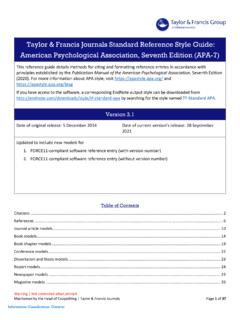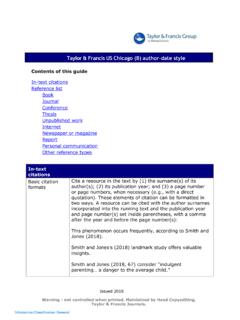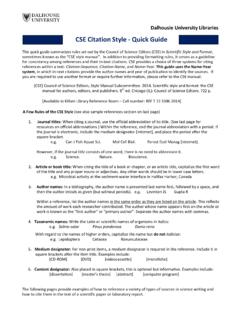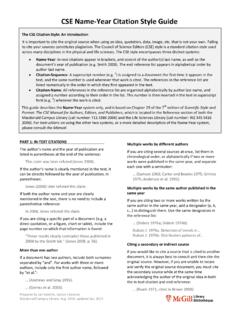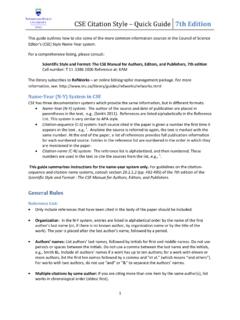Transcription of Taylor & Francis Standard Reference Style | CSE
1 Warning | Not controlled when printed Maintained by Head of Copyediting | Taylor & Francis | Journals Page 1 of 15 Information Classification: General Taylor & Francis Standard Reference Style | CSE CSE (Council of Science Editors) citations are widely used for scientific journals and are based on international principles adopted by the National Library of Medicine. This guide is based on examples given in Scientific Style and Format: The CSE Manual for Authors, Editors, and Publishers, 8th edition, 2014. NB: examples in the CSE Manual mostly follow the citation - name system, so need to be converted for this name - year system. If you are using this Reference Style the EndNote output Style can be found at Version Date of issue: 31 March 2014 Date of version: 28 September 2021 Update in this version: FORCE11-compliant software models added Contents In the text.
2 2 Tables and figures .. 4 Reference list .. 4 Journal .. 5 8 Conference .. 11 Dissertation/Thesis .. 11 Unpublished work .. 11 Online sources .. 12 Newspaper/Magazine .. 13 Report .. 13 Personal communication .. 14 Other Reference types .. 14 Warning | Not controlled when printed Maintained by Head of Copyediting | Taylor & Francis | Journals Page 2 of 15 Information Classification: General In the text Placement In-text references generally consist of the surname of the author(s) and the year of publication of the document. Enclose the name (s) and year in parentheses. No punctuation appears between name and year . An in-text Reference should immediately follow the word, title or phrase to which it is directly relevant, rather than appearing at the end of long clauses or sentences. Separate in-text references from adjacent text by single spaces before and after them, except when they are followed by a punctuation mark.
3 For example: The most recent report (Slack 2002) on the use of .. If works by the same author or author group are cited close to a mention of the author s name in the text and there is no uncertainty as to author identification, the in-text Reference may be limited to the publication year . For example: Chen s studies (1990, 1992, 1994) were examined closely .. Multiple references When several in-text references occur at the same point, give them in chronological order from earliest to latest, separated by semicolons. Sequence by month those published in the same year or, if this information is not available, alphabetically by author names. (Dawson and Briggs 1974; Dawson and Jones 1974; Smith AL 1978; Smith GT 1978; Smith et al. 1978; Tyndall et al. 1978; Zymgomoski 1978; Brown 1980) Page number (Smith 2016, p. 6) Page number ranges are also preceded by p.
4 And a space, and linked with an en dash, p. 56 63 . Page number ranges are not elided. With a quotation This is the text, and Smith (2016) says "quoted text" (p. 1), which supports my argument. This is the text, and this is supported by "quoted text" (Smith 2016, p. 1). This is a displayed quotation. (Smith 2016, p. 1) One author Smith (2016) or (Smith 2016). Distinguish multiple works by the same author published in different years by placing the years after the author name in chronological sequence, separated by a comma and a space (Smith 1970, 1975). If the authors of two works published in the same year have the same surname, include their initials in the in-text Reference and separate the two in- text references by a semicolon and a space (Dawson J 1986; Dawson M 1986). Warning | Not controlled when printed Maintained by Head of Copyediting | Taylor & Francis | Journals Page 3 of 15 Information Classification: General Two authors Smith and Jones (2016) or (Smith and Jones 2016).
5 If both authors have the same surname, include their initials in the in-text Reference (Smith TL and Smith UV 1990). Three or more authors Give only the first author s name followed by et al. (not in italics) and the year of publication, Smith et al. (2016) or (Smith et al. 2016). Multiple works by the same author (or group of authors) in the same year Put a, b, c, etc. after the year . The sequence is preferably determined by the sequence of publication, but if this cannot be determined, order alphabetically by article title (Chen 2011a, 2011b; Chen et al. 2016a, 2016b). Non-identical groups of authors with the same first author If the first author s names and the years of publication are identical for several references, cite the surname of the first author and as many co-authors as necessary to distinguish the references, followed by et al.
6 Include just enough names to eliminate ambiguity. For example: (Martinez, Fuentes, et al. 1990) or (Martinez, Fuentes, Ortiz, et al. 1990), depending on what other Martinez et al. 1990 references are cited. Organization as author If the organization s name occurs several times in the document, a shortened form may be created for the in-text Reference by using an abbreviation. For clarity, the abbreviation appears as the initial element in the end Reference , within square brackets. In the text: (IOM 1975) In the Reference list: [IOM] Institute of Medicine (US). 1975. Organizations full names are acceptable in in-text references if they occur only infrequently (Institute of Medicine 1975). No identifiable author If the authorship cannot be determined, do not use anonymous . Instead, begin the in-text Reference with the first word or first few words of the title (just enough to distinguish it from any other titles being used as references), followed by an ellipsis.
7 For example: ( 2000). Secondary source When it is not possible to see an original document, cite the source of your information on it; do not cite the original assuming that the secondary source is correct. Personal communication References to personal communications are cited only in the text.. and most of these proved to be fatal (2003 letter from RS Grant to me; unreferenced, see Notes ) .. Warning | Not controlled when printed Maintained by Head of Copyediting | Taylor & Francis | Journals Page 4 of 15 Information Classification: General Multiple dates For in-text references to publications with a range of dates, give the first and last years of publication linked with an en dash: (Author 1959 1963) Unknown date For in-text references to publications with no date, place the words date unknown within square brackets (Author [date unknown]).
8 Tables and figures In-text references in a table are usually most appropriately put in footnotes to the table. If in-text references must appear within the field of a table, use a separate column or row for them and supply an appropriate heading to identify them. Do not use in-text references within figures, charts, graphs or illustrations. If such references are needed to support the data or methods, put them in the caption. Reference list Order At the end of a document, list the references to sources that have been cited within the text, including those found in tables and figures, under the heading References. Place references in alphabetical order by author. Alphabetical sequence is determined by the first author s surname (family name ) and then, if necessary, by letter-by-letter alphabetical sequencing determined by the initials of the first author and the beginning letters of any subsequent authors surnames.
9 Order references by the same author(s) by year in ascending order. If there are several items with the same first author, alone and/or with co-authors, present items by a single author before items with co-authors, regardless of title. In such a grouping, give the multi-author publications in alphabetical order by the second author s surname, regardless of the number of authors. When organizations serve as authors, drop The in an organizational name for the purposes of alphabetizing (unless The is part of the official name of the organization), American Chemical Society , not The American Chemical Society . When initials have been used for an organization as the in-text Reference , order the Reference by the full name , not the initials so that in the list, [ACS] American Chemical Society precedes [ABU] Australian Biochemical Union.
10 If no authors are present, order items by title, following these principles: ignore a , an and the at the beginning of a title when alphabetizing. Order initials and acronyms in document titles as if they were words, not by the full name for which they stand. Order a title beginning with a number as if it were written out in words. Warning | Not controlled when printed Maintained by Head of Copyediting | Taylor & Francis | Journals Page 5 of 15 Information Classification: General Form of author name Begin with the surname (family name ), followed by the initials without punctuation and without spaces, hyphens or full points between them, Author AA. Separate successive author names from each other by a comma and a space, Author AA, Author BB. Capitalize surnames and enter spaces within surnames as they appear in the document being cited, Van Der Horn or van der Horn; De Wolf or de Wolf or DeWolf.

